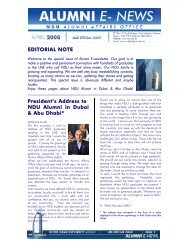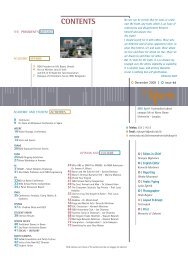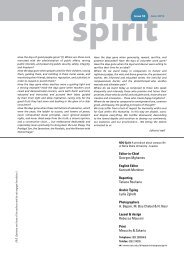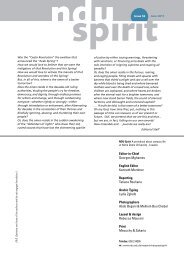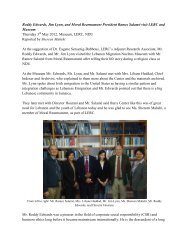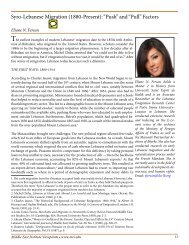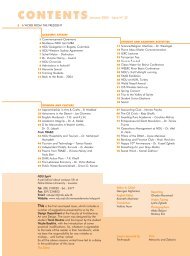OUTLINE - Notre Dame University
OUTLINE - Notre Dame University
OUTLINE - Notre Dame University
You also want an ePaper? Increase the reach of your titles
YUMPU automatically turns print PDFs into web optimized ePapers that Google loves.
DR. S. SAGHIEH<br />
ON<br />
OSTEOPOROSIS<br />
REPORT BY DR. NAJAT YAHIA<br />
O n January 16 th , 2003, the Department of Sciences invited<br />
Dr. S. Saghieh. M.D. “Orthopedic Division, Section<br />
of Limb Lengthening & Reconstruction-AUB-MC” to give a<br />
lecture about osteoporosis. This is a brief summary of his<br />
talk.<br />
Osteoporosis is a disease characterized<br />
by low bone mass and microarchitectural<br />
deterioration of bone tissue<br />
leading to increased bone fragility<br />
and a consequent increase in fracture<br />
risk. Bone is a living growing<br />
tissue. It is mostly made of collagen<br />
and calcium phosphate. More than<br />
99% of the body's calcium is contained<br />
in the bones and teeth. The<br />
remaining 1% is found in the blood.<br />
There are two types of bone: compact<br />
and spongy. Each bone in the<br />
body has both types of bone in different<br />
amounts. The first signs of<br />
osteoporosis are seen in bones that<br />
have a lot of spongy bone: the hip,<br />
spine, and wrist bones. As the structural<br />
integrity of trabecular bone is<br />
impaired and the cortical bone<br />
becomes more porous and thinner,<br />
the bone becomes weaker and more<br />
likely to fracture.<br />
Throughout lifetime, old bone is<br />
removed (resorption) and new bone<br />
is added to the skeleton (formation).<br />
Bone formation continues in this<br />
way at a pace faster than resorption<br />
until peak bone mass (maximum<br />
bone density and strength) is<br />
reached around age 30.<br />
After age 30, bone resorption slowly<br />
begins to exceed bone formation.<br />
Osteoporosis develops when bone<br />
resorption occurs too quickly or if<br />
replacement occurs too slowly.<br />
Moreover, osteoporosis is more likely<br />
to develop if the bone density did<br />
not reach the optimal bone mass<br />
during the bone-building years. In<br />
addition, bone loss is most rapid in<br />
the first few years after menopause<br />
but persists into the postmenopausal<br />
years.<br />
In the USA, about 21% of postmenopausal<br />
women have osteoporosis,<br />
and about 16% have had a<br />
fracture. In women older than 80,<br />
about 40% have experienced a fracture<br />
of the hip, vertebra, arm, or<br />
pelvis.<br />
Osteoporosis is considered a "silent<br />
disease" because bone loss occurs<br />
without symptoms. People may not<br />
know that they have osteoporosis<br />
Dr. Saghieh illustrates his talk.<br />
until their bones become so weak<br />
that a sudden strain, bump, or fall<br />
causes a fracture or a vertebra to collapse.<br />
Risk factors of osteoporosis include:<br />
➢ Weight below healthy range.<br />
➢ A diet low in calcium and vitamin<br />
D.<br />
➢ Sedentary lifestyle.<br />
➢ Low hormone levels associated<br />
with menopause.<br />
➢ Medicines such as corticosteroids<br />
and certain medicines for<br />
seizures or high blood pressure.<br />
➢ Cigarette smoking.<br />
➢ Excess alcohol intake.<br />
For diagnosis, there are several criteria<br />
to consider in the light of clinical<br />
evaluation, medical history, risk factor<br />
assessment tests, bone mineral<br />
density (BMD) testing, physical<br />
examination, DXA diagnosis and<br />
other laboratory tests. Screening<br />
bone density tests carry no physical<br />
risks and screening of patients is<br />
important in order to –<br />
32 NNU SPIRIT



